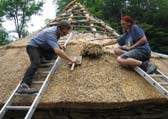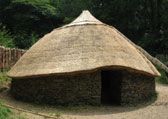The Project: St Fagans 05
In 2005 St. Fagans National History Museum called in The Roundhouse Project to build a new roof for one of their Roundhouses. Their Celtic Village has three Roundhouses, and the one that needed attention was the stone-walled house, based on an excavation in Conderton, Worcestershire. The old roof had been removed a couple of years previously, and the wall repaired ready for us to begin.
The framework was made from Ash poles stripped of their bark, which were harvested from Coed Hills Rural Artspace during the previous Winter. We opted for the same design as our own Roundhouse, using ring-beams to spread the distribution of rafters down the roof. Three rafters were cut to length, and hoisted into place. With the aid of a scaffold tower, we lashed these three together. Just under the newly formed apex, we lashed on three small horizontal sticks that held the ends of the next set of three rafters. After that we installed the first ring-beam, cupping out the horizontal members, so that they sat snugly on the rafters, and lashed them in place. We attached the next set of rafters to this ring-beam. Further down the roof we installed another ring-beam, and another set of rafters. Finishing the frame was a third ring-beam, that sat on the stone wall, and held the base of every rafter at the correct distance apart.
The roof was then covered in horizontal Hazel sticks, called purlins. These were lashed in place at intervals of fourteen inches, and held the thatch. It took six weeks to build the frame, and six weeks to thatch.
Home | News
| First Roundhouse | New
Roundhouse |Gallery Index
The Project | Resources
| Contact | Help
All content: © The Roundhouse Project 1997-2007





